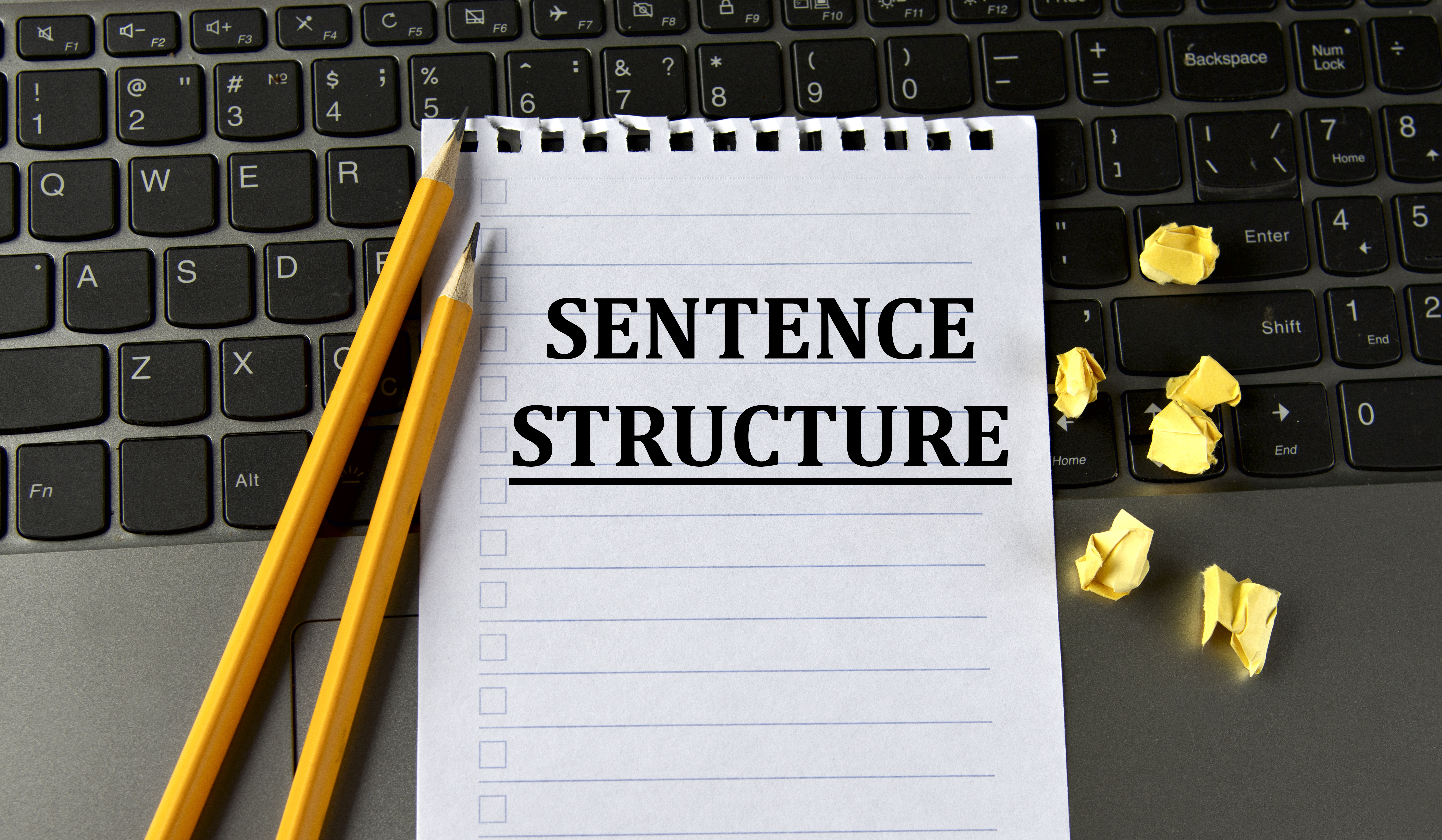
When it comes to academic writing, grammar is incredibly important, especially if the document is intended for publication. A manuscript could contain the most incredible research, but if it is littered with grammatical errors, it will likely be rejected.
Regardless of how well you can speak English, writing in English is completely different. There are several rules to follow, and it can be challenging to make sure you follow every single one of them.
Studying and understanding sentence structure, for example, can improve your academic writing and take it to a new level of complexity. Purposefully forming and ordering sentences can create rhythm in your writing and enhance the reader’s experience. As a result, you will become a more thoughtful and varied writer.
In this blog, you will learn what sentence structure is, the four different types of sentence structure, and some helpful tips on how to avoid common mistakes in sentence structure.
What Is Sentence Structure?
Sentence structure is the way in which words are put together to create a sentence. Every sentence in the English language contains an independent clause, which forms a complete thought when standing alone. A basic independent clause follows the word order of Subject (a noun performing an action) + Verb/Verb Phrase (the action of the subject) + Object (the noun receiving the action).
Here is an example of an independent clause:
- She (subject) has (verb) a book (object).
You can build from this foundation to then add prepositional phrases, dependent clauses, and coordinating conjunctions. When you add some of these other elements, you create a certain type of sentence structure. The four types of sentence structure include:
- Simple sentences
- Compound sentences
- Complex sentences
- Compound-complex sentences
What Is a Simple Sentence?
Simple sentences are the most basic English sentence structure. They are independent clauses, which form complete thoughts when standing alone.
Like all sentences, simple sentences can contain a direct object and an indirect object. Direct objects are nouns that receive the action or effect of the verb whereas indirect objects are nouns for whom the action is being done.
Here is an example of a simple sentence:
- She (subject) gave (verb) a book (direct object) to me (indirect object).
Direct objects answer the “What?” question whereas indirect objects answer the “For what?” or “For whom?” questions.
To demonstrate:
- She gave. (She gave what?) A book. (She gave a book to whom?) She gave a book to me.
Here are some additional examples of simple sentences:
- She (subject) baked (verb) a cake (direct object).
- He (subject) drove (verb) a car (direct object).
- I (subject) threw (verb) him (indirect object) the ball (direct object).
- The author (subject) wrote (verb) a book (direct object) for his daughter (indirect object).

What Is a Compound Sentence?
A compound sentence is a combination of two simple sentences, or independent clauses, that are joined together by either a semicolon or a coordinating conjunction (for, not, but, or, so, and).
For the following examples of compound sentences, independent clauses are highlighted in green, and the coordinating conjunction or semicolon is highlighted in blue:
- She is at work,and her husband is at home.
- My dog was sick, so I took her to the vet.
- He does not like broccoli, but he does like asparagus.
- Daisy kept playing; she had a lot of energy.
You can easily break down each of these compound sentences into two simple sentences:
- She is at work. Her husband is at home.
- My dog was sick. I took her to the vet.
- He does not like broccoli. He does like asparagus.
- Daisy kept playing. She had a lot of energy.
What Is a Complex Sentence?
A complex sentence is a combination of an independent clause and a dependent clause. Unlike compound sentences, complex sentences cannot be broken down because a dependent clause is not a complete thought that can stand on its own. As a result, a dependent clause must be attached to an independent clause. A dependent clause is also known as a subordinate clause because it begins with a subordinating word, such as “if,” “when,” “although,” “whoever,” and “because.”
In these examples of complex sentences, dependent clauses are highlighted in yellow whereas independent clauses are highlighted in green:
- Although he had a headache, he completed his homework.
- She went home because she needed to let her dog outside.
- When you drive, you must focus on the road.
- I will watch the horror movie if you watch it with me.

What Is a Compound-Complex Sentence?
As its name suggests, a compound-complex sentence combines elements of compound and complex sentences. Every compound-complex sentence contains two or more independent clauses and at least one dependent clause.
For the following examples of compound-complex sentences, dependent clauses are highlighted in yellow, independent clauses are highlighted in green, and the coordinating conjunction or semicolon is highlighted in blue:
- Although Kyle prefers his car, he drove Courtney’s car, and he thoroughly enjoyed it.
- If your joke was funny, I would laugh, and you would be happy.
- Since you did not show up to work, Jessica had to cover your shift, and I was angry.
- Whoever is making that noise, you need to stop; it is very annoying.
Common Mistakes in Sentence Structure and How to Avoid Them
Three of the most common errors in sentence structure are:
- Run-on sentences
- Sentence fragments
- Comma splices
Run-On Sentences
Run-on sentences occur when two independent clauses are not joined in a grammatically correct way (typically without proper punctuation).
Here are a few examples of run-on sentences:
- The dog barked the bird flew away.
- He was tired he went to bed.
- I tried to jump I could not.
In order to make these run-on sentences grammatically correct, you can create compound sentences by joining the two independent clauses with a coordinating conjunction or semicolon.
To demonstrate:
- The dog barked; the bird flew away.
- He was tired, so he went to bed.
- I tried to jump, but I could not.

Sentence Fragments
Sentence fragments are incomplete sentences. They do not form a complete thought and cannot stand alone.
It is worth noting that when it comes to journalism and creative writing, authors use sentence fragments for stylistic purposes. However, sentence fragments are inappropriate in academic writing.
Here are a few examples of sentence fragments and some possible ways to fix them:
-
Fragment: Since she likes music.
- Fix #1: Remove “Since.” → She likes music.
- Fix #2: Form a complex sentence. → Since she likes music, she bought concert tickets.
-
Fragment: When you go to bed.
- Fix #1: Remove “When.” → You go to bed.
- Fix #2: Form a complex sentence. → Please shut your door when you go to bed.
-
Fragment: The dog that has a white nose.
- Fix #1: Remove “that.” → The dog has a white nose.
- Fix #2: Add a verb. → The dog that has a white nose ran away.
Comma Splices
A comma splice (CS) occurs when two independent clauses are joined together by a comma, which is a grammatically incorrect way to combine independent clauses.
Here is an example of a comma splice and some possible ways to fix it:
- Comma splice: She submitted her assignment late, the project was too much for her to handle.
- Fix #1: Form a complex sentence by creating a dependent clause. → She submitted her assignment late because the project was too much for her to handle.
- Fix #2: Form a compound sentence by replacing the comma with a semicolon. → She submitted her assignment late; the project was too much for her to handle.
- Fix #3: Create two sentences. → She submitted her assignment late. The project was too much for her to handle.
How eContent Pro Can Help
At eContent Pro (eCPro), we have an incredible team of professional copy editors who can help make sure your sentence structure is error-free and at the level it needs to be for manuscript publication. Our native English-speaking copy editors and certified proofreaders are highly experienced and specialize in over 10 research areas, ensuring that your document is in good hands.

We take pride in providing top-notch editorial services that are tailored to meet the needs of our clients. With over 20 years of experience in the publishing industry, we have earned a reputation for delivering high-quality work that is error-free and polished to perfection at the quickest turnaround time.
In addition, we use Microsoft Word's Track Changes feature to perform edits, allowing you to easily review and manage the changes made to your document. We also follow various style guides, including APA 7th edition, MLA, AP, Harvard, Chicago, and more, to ensure that your document adheres to the standards set by your academic institution or publisher.
Make the Correct Choice
eCPro is committed to providing excellent service at a competitive price. Our English Language Copy Editing and Proofreading service costs just US $0.06 per word, with a turnaround time of 2-3 business days at no extra cost. Your total cost of copy editing will also benefit from our current 10% academic discount.
Contact us today to learn more about our editorial services and how we can help you achieve your publishing goals. With our team of experts by your side, you can be confident that your document will be polished to perfection and ready to stand out in the competitive publishing landscape.